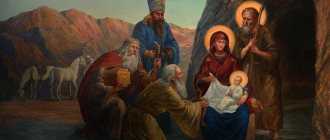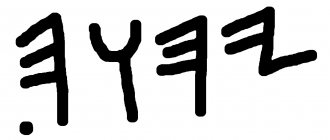The Nativity of Christ in chronology from the creation of man
Tree of Jesse (Genealogy of Jesus Christ) Russia. Second half of the 17th century.
According to the Orthodox (Byzantine) calendar, rejected by the Western Church in the middle of the 16th century, and by the Russian Church - by the reforms of Peter I at the beginning of the 18th century, the Nativity of Christ (R.C.) took place 5508 years after the creation of the “human race”, or “world” - in Church Slavonic. Professor A.P. Lopukhin in the book “Biblical History of the Old Testament” noted the difficulties, but not the hopelessness of restoring the chronology of Old Testament events from Adam.
The purpose of the message is to show the results of calculating the number “5508 years” based on the texts of the first translation of the lost original Hebrew books of the Old Testament, made by Israeli translators in the 3rd-2nd centuries BC. (Septuagint) and preserved until the 21st century in the Bible, published by the RBO in Russian with the blessing of His Holiness Patriarch Alexy II of Moscow and All Rus'.
The first two chapters of Genesis indicate six days of creation. In the sixth day-period of creation, when “the Lord God did not send rain on the earth... but steam rose from the earth...” (Gen. 2: 5, 6) and when there was not yet “a rainbow in the cloud” (Gen. 9: 12–17 ), God created man - “male and female he created them... and called their name man on the day of their creation” (Gen. 5: 1–2). A distinctive feature of a person, according to Vavilov, is a “homogeneous unit of heredity,” that is, his “gene” with male and female chromosomes.
According to the book of Genesis (see: Gen. 5: 3–31), Adam lived 230 years and gave birth to Seth; Seth lived 205 years and gave birth to Enosh. After 190 years, Enosh gave birth to Cainan; after 170 years, Cainan gave birth to Maleleid; 165 years later Maleleid gave birth to Jared; 162 years later Jared gave birth to Enoch; 165 years later Enoch gave birth to Methuselah; 187 years later Methuselah gave birth to Lamech; 188 years later Lamech gave birth to Noah. “Noah was five hundred years old, and Noah begat three sons: Shem, Ham and Japheth” (Gen. 5:32). Since Shem is older than Ham and Japheth (see: Gen. 9: 22–24; 10: 21), then at the age of 500 Noah gave birth to Shem. Thus, Shem was born in 230+205+190+170+165+162+165+187+188+500 = 2162 from the day of the creation of man (from S.Ch.).
And Noah lived after the flood three hundred and fifty years
“Now Noah was six hundred years old when the flood of water came upon the earth” (Gen. 7:6). “And Noah lived after (the beginning of) the flood three hundred and fifty years. And all the days of Noah were nine hundred and fifty years, and he died” (Gen. 9: 28–29). The correctness of the inserted word confirms the equality 600 + 350 = 950. By analogy, “She was a hundred years old (when the flood of water came to the earth) and gave birth to Arphaxad two years after (the beginning of) the flood...” (Gen. 11: 10), that is at the age of 102 years. Further (see: Gen. 11: 12–25), Arphaxad lived 135 years and gave birth to Cainan. After 130 years, Cainan gave birth to Salah; 130 years later Salah gave birth to Eber; after 134 years Eber gave birth to Peleg; 130 years later Peleg gave birth to Raghav; 132 years later Raghav gave birth to Serukh; 130 years later Serukh gave birth to Nahor; 79 years later Nahor gave birth to Terah. Therefore, Terah was born in 2162+102+135+130+130+134+130+132+130+79 = 3394 A.D.
“Terah lived seventy years and begat Abram, Nahor and Haran”; of them, the eldest was Aran (see: Gen. 11: 26–29). Since Terah died in Haran at the age of 205, when Abram was 75 years old (see: Gen. 11: 31–32; 12: 4–5), then Terah gave birth to Abram at the age of 205–75 = 130 years. Abram-Abraham gave birth to Isaac at the age of 100 (see: Gen. 17: 1–6; 21: 5). Isaac gave birth to Jacob at the age of 60 (see: Gen. 25: 25–26; 35: 28), that is, in 3394+130+100+60 = 3554 from N.C.
Jacob gave birth to Joseph (see: Gen. 30: 22–24). At the age of 17, Joseph was sold by his brothers into Egyptian slavery (see: Gen. 37: 2–28): prof. A.P. Lopukhin notes that thirty-year-old Joseph was a slave for 13 years. At the age of 30, Joseph was presented to Pharaoh (see: Gen. 41: 14–16, 46); after seven years of plenty and two years of famine (see: Gen. 41: 25–30; 45: 4–11), Joseph sent his brothers for their father, providing them with “chariots by order of Pharaoh and ... traveling supplies” for speed (Gen. 45:21). Jacob, who arrived in Egypt with his family, was presented to Pharaoh at the age of 130 (see: Gen. 47: 7–9). Consequently, Jacob-Israel (see: Gen. 32: 28) gave birth to Joseph at the age of 130–(30+7+2)= 91 years. And since the brothers who moved to Egypt, at the request of Joseph, called themselves slaves of Pharaoh (see: Gen. 46: 33–34; 47: 3–4), then the beginning of the captivity of the future Israeli people should be considered 3554 + 91 + 17 = 3662 from C .Ch.
In the book of Exodus, the duration of Egyptian slavery is repeated twice (see: Exodus 12: 40–41): “And the time in which the children of Israel and their fathers dwelt in Egypt and in the land of Canaan was four hundred and thirty years. After four hundred and thirty years, on this very day (the first month - Ex. 12: 1-11)), all the army of the Lord came out of the land of Egypt at night.” Consequently, the exodus of the Israeli people from Egypt occurred in 3662 + 430 = 4092 A.D.
“In the four hundred and eightieth year after the children of Israel came out of the land of Egypt, in the fourth year of Solomon’s reign over Israel, in the month Ziph, which is the second month, he began to build the temple of the Lord” (1 Kings 6:1). “The time of Solomon’s reign in Jerusalem and over all Israel was forty years” (1 Kings 11:42; 2 Chronicles 9:30). After the death of Solomon, his kingdom was divided into Judah and Israel (see: 1 Kings 11: 30–32; 12: 20–24). This event occurred in 4092+480+(40–4) = 4608 from S.Ch.
It was in 4608 from the day of the creation of man that Rehoboam (son of Solomon) reigned in Judah (see: 1 Kings 12:17; 14:21; 2 Chronicles 12:13), and Jeroboam reigned in Israel (1 Kings 12: 20; 14:20). Here and below, the names of the Israeli kings are in italics, the duration of the reign is shown in parentheses after the name of the kings, more reliable underlined numbers are used in subsequent calculations of the year of accession from the year of division of the kingdom of Solomon (from R.C.S.).
The books of Kings and Chronicles give not only the years of reign of the 20 kings of Judah and 20 of Israel, but also the agreed upon years of their accession to the throne. So, Asa reigned: after Rehoboam (17) and Abijah (3) - 17+3 = 20 years; “in the 20th year of the reign of Jeroboam king of Israel” (1 Kings 15:9). According to the second option, the accession could have occurred both at the beginning and at the end of the 20th year of Jeroboam’s reign, and therefore the year of Asa’s accession should be considered the number 19.5 with an error of ±0.5 years, that is, 19.5 (±0.5) year from R.C. WITH.
Ahab reigned: after Jeroboam (22 years), Nebat (2), Baasha (24), El (2), Zimri (7 days), Omri (12) and Tamni (6, at the same time as Omri); in the 38th year of Asa (see: 3 Kings 16: 29), that is, in (19.5±0.5)+(37.5±0.5) = 57(±1) year. Jehoshaphat reigned: in the 4th year of Ahab (see: 3 Kings 22: 41–42) – (57±1)+(3.5±0.5) = 60.5(±1.5); after Asa (41) – (19.5±0.5)+41 = 60.5(±0.5). Jehoram reigned: after Ahab (22) and Ahaziah (2); in the 18th year of Jehoshaphat (see: 2 Kings 3: 1) – (60.5±0.5)+(17.5±0.5) = 78(±1). Jehu killed Ahaziah and Joram (see: 2 Kings 9: 23–28) and Gotheliya reigned after Jehoshaphat (25), Joram (8) and Ahaziah (1) and Jehu after Joram (12) in (78±1) +12 = 90(±1) year from R.C.S.
Joash reigned: in the 7th year of Jehu (see: 2 Kings 12: 1) – (90±1)+(6.5±0.5) = 96.5(±1.5); after Gophelia (6) – (90±1)+6 = 96(±1). Joash reigned: after Jehu (28) and Johaz (17); in the 37th year of Joash (see: 2 Kings 13: 10–11) – (96±1)+(36.5±0.5) = 132.5(±1.5). Amaziah reigned: after Joash (40); in the 2nd year of Joash of Israel (see: 2 Kings 14: 1–2) – (132.5±1.5)+(1.5±0.5) = 134(±2). Jeroboam (the second) reigned: in the 15th year of Amaziah (see: 2 Kings 14:23) – (134±2)+(14.5±0.5) = 148.5(±2.5); after Joash (16) – (132.5±1.5)+16 = 148.5(±1.5). Azariah-Uzziah reigned: 15 years after the death of Joash (16) (see: 2 Kings 14: 17; 2 Chronicles 25: 25) – (132.5±1.5)+16+15 = 163.5(±1.5); after Amasia (29) – (134±2)+29 = 163(±2). Pekah reigned: after Jerovaam (41), Zechariah (6 months), Shallum (1 month), Menael (10) and Pakiah (2); in the 52nd year of Azariah (see: 2 Kings 15: 27) – (163±2)+(51.5±0.5) = 214.5(±2.5). Ahaz reigned: in the 17th year of Pekah (see: 2 Kings 16: 1–2) – (214.5±2.5)+(16.5±0.5) = 231(±3); after Azariah-Uzziah (52) and Jotham (16) – (163±2)+52+16 = 231(±2). Hoshea reigned: after Pekah (20); in the 12th year of Ahaz (see: 2 Kings 17: 1–2) – (231±2)+(11.5±0.5) = 242.5(±2.5). Hezekiah reigned: after Ahaz (16); in the 3rd year of Hoshea (see: 2 Kings 18: 1–2) – (242.5±2.5)+ (2.5±0.5) = 245(±3) year from R.C.S.
Zedekiah reigned after Hezekiah (29), Manasseh (55), Amon (2), Josiah (31), Jehoahaz (3 months), Joachim (11) and Jeconiah (3 months) in (245±3)+29+55+ 2+31+0.25+11+0.25 = 373.5(±3) year (from R.C.S.). It should be noted that, according to 2 Kings. 21:1, Manasseh reigned 50 years, while the figure used in the calculation, 55, is given in 2 Chron. 33: 1, in the book of prof. Lopukhin and in two books of Tanakh1. The Babylonian captivity began when Nebuchadnezzar deported Jeconiah (with his family), “the princes, the army, the carpenters, the artists, the builders... with the treasures of the house of the Lord and the king’s house” from Jerusalem to Babylon (2 Kings 24: 11–16; 2 Chron. 36 : 6–7). In enslaved Jerusalem, Nebuchadnezzar enthroned Zedekiah (see: 2 Kings 24: 17–18), taking an oath from him to faithful service (see: 2 Chron. 36: 11–13), and therefore the beginning of the Babylonian captivity should be considered 4608+ (373.5±3) = 4981.5(±3) year from S.Ch.
According to the prophecy of Jeremiah (see: Jer. 25: 11–12; 29: 10–14) and according to the chronicles (see: 2 Chron. 36: 20–21), the Babylonian captivity lasted 70 years. The captivity ended with the decree of Cyrus, king of Persia, on the construction of a temple in Jerusalem, after which the captives returned to “their cities” with the returned jewelry (see: 2 Chron. 36: 22–23; 1 Ezra 1: 1–11, 2; 2 Rides 2:1–15). This event occurred in (4981.5±3)+70 = 5051.5(±3) year from S.Ch.
"Seventy weeks are determined for your people"
The length of the period predicted by the prophet Daniel between the liberation from Babylonian captivity and the putting to death of Christ the Savior is repeated twice in Dan. 9: 24–27): “Seventy weeks (translated as seven years) are determined for your people and your holy city... Therefore, know and understand: from the time the commandment goes out to restore Jerusalem until Christ the Lord, there are seven weeks and sixty-two weeks... And the covenant will be established for many in one week, and in half the week sacrifice and offering will cease...” Jesus Christ began His ministry at the age of 30 (see: Luke 3:23) and served “half the week”, accepting death on the cross in at the age of 33.5 years - this is what Archbishop Averky writes in his book “The Four Gospels”. Thus, the Nativity of Christ took place in (5051.5±3)+(70×7) – 33.5 = 5508(±3) year from the day of the creation of man (male and female), which coincides with the number “5508 years” in the Orthodox calendar.
The very possibility of the calculations shown testifies to the Divine origin of the Bible texts.
Jewish World
In the beginning, G‑d created the entire universe with all its parameters and components, including time, from “nothing.” The creation process took six days. On the seventh day, G-d “rested” by creating a spiritual environment called “Sabbath” that visits us once a week. On the eve of the first Shabbat, the first people were born - Adam and Chava. G-d placed them in the Garden of Eden. At the instigation of the Serpent and contrary to the categorical prohibition of the Creator, Chava tasted the forbidden fruit from the “Tree of the Knowledge of Good and Evil” and gave this fruit to Adam to try. Having thus absorbed “sin,” Adam and Chava could no longer remain in the spiritual paradise of Eden. G‑d expels violators from the “Garden of Eden” and changes the nature of people. Death, toil and birth pangs come into the world. The eternal struggle between good and evil begins for the atonement of the original sin of Adam and Chava, which has become the core of world history. Cain and Abel, the first children of Adam and Chava, bring gifts to G-d: Cain - “from the fruits of the earth”, Abel - “from the firstborn of his sheep.” The Most High accepts Abel's gift and rejects Cain's offering. A dispute arises between the brothers, and the annoyed Cain kills Abel. For this, G-d sentences him to eternal wanderings. Next, the genealogy of the descendants of Cain and the descendants of Adam and Chava is traced through the line of their third son Sheth - until the birth of Noah. After Sheth's death, humanity deteriorates morally. G-d “regrets” that he created people and decides to destroy them with a Flood, saving the only righteous person of that era - Noach and his family.
The “Beresheet” section is extremely rich in events and phenomena covering a huge layer of existence (in the Russian tradition, this first book of the Pentateuch is called “Genesis”) - from the primary chaos from which G-d created the universe and time, and until the Flood; from the first man Adam to Noah, the only righteous man in his generation. It was from the “Beresheet” section that the classic characters of Adam, Chava (Eve) and the Tempter Serpent, the concept of “original sin”, and the fratricidal plot with the participation of Cain and Evel (Abel) entered world culture. Here we learn that the ten “antediluvian” generations from Adam to Noah were super-long-livers. One of them, Methuselah (Methuselah), set an absolute longevity record - 969 years! From this same first section, humanity has borrowed many catchphrases, allegories and metaphors that have spread throughout world languages, penetrated into literature, journalism and drama, adding depth and imagery to modern speech. People have long forgotten about the original source, but they readily quote: “Let there be light” (1:2); “And there was evening and there was morning” (1:5); “And God created man in His own image and likeness... and said: “Be fruitful and multiply, and fill the earth and subdue it” (1:27,28); “The Tree of the Knowledge of Good and Evil” (2:9); “It is not good for a man to be alone” (2:18); “This is bone of my bone, flesh of my flesh” (2:23); “Therefore a man leaves his father and his mother and is united to his wife, and they become one flesh” (2:24); “By the sweat of your face you will eat bread... for you are dust, and to dust you will return” (3:19); “Cain rose up against his brother Ebel and killed him” (4:8); “Am I my brother’s keeper?” (4:9). The expression “Cain’s seal” is also from the Torah: “And G‑d gave Cain a sign, so that whoever met him would not kill him” (4:15).
Blessed letter "Beit"
People who first opened the Pentateuch probably noticed the large first letter “Beit.” This is not the only font anomaly of this kind. According to tradition, Torah scrolls are written with a total of 11 letters larger than the rest of the script and five to six small letters. The Torah begins with a big “beit.” The Jerusalem Talmud and other sources explain this feature differently. Beit is a bracha, a blessing. Since the first letter of the Hebrew alphabet is aleph, it would, at first glance, be logical and fair to place it first in the Torah. However, the word “arur”, cursed, begins with “aleph”. The Midrash says that G‑d wanted to give this world the optimal opportunity for survival and therefore blessed it with the first capital letter “beit.” But it's not just about letters and words. "Beit" symbolizes multitudes; its numerical value is two, the minimum plural. “Aleph” is one, a unity that suits only G-d, but not man, for, as stated in our section, “it is not good for man to be alone.” Instead of unity, we get loneliness. In addition, “beit” represents two worlds created by the Creator: this world and the World to Come, the existence of which we must know. The big “bate” reminds us of this. Finally, another explanation - graphic. The letter "beit" forms three sides of a rectangle. It is closed at the top, bottom, back and open at the front. This leads to an important ideological position: we should not spend too much time and effort on finding out what is happening above (in the Higher spheres), below (in “gehenom”, hell) and behind us (in previous worlds that existed before the Creation of our universe ). Our attention and curiosity must be directed forward into this world, from the moment of its origin and further into the future.
From now to now
“And the Lord God took the man and placed him in the Garden of Eden to cultivate and keep” (2:15).
What to cultivate and what to protect? At first glance, everything is clear: Adam was placed in Eden to cultivate and protect the Garden of Eden. But why then are these two verbs used with a feminine ending: “leovda u-leshomra”? After all, garden, “gan,” is masculine. So this is not about him. Adam was entrusted with cultivating and protecting his soul (in Hebrew “neshamah”, soul, as in Russian, is feminine). But how is this possible? — By fulfilling one simple commandment: not to eat fruit from the Tree of the Knowledge of Good and Evil. It would seem that it could be easier? Sit in the Garden of Eden and don’t do what you’re not told to do. But Adam managed not to fulfill this only “childish” mitzvah, although he was never a child. Why did Adam decide to taste the fruit from this forbidden tree? What came over him? Did your proactive wife fail you? No, it’s more complicated and deeper. Before Adam tasted this fruit, evil existed only in its infancy, outside of Adam. By violating the ban, the first person absorbed evil and thereby realized and revealed it. But why did Adam need to “infect” himself with evil? Why voluntarily take poison? Adam was not born, like all people, from flesh and blood parents. He was created by the Creator Himself supernaturally in the guise of an adult man and wanted to serve Him with all his might, with all his capabilities. Adam thought that if serving G‑d consists in refraining from eating fruit containing incipient evil, then one must lure the “enemy” into one’s territory and then defeat him—for the glory of the Creator! You can't think of a better form of service. As we see, Adam had the purest and most worthy thoughts. But he made a fatal mistake. By their involuntary fall, Adam and his wife Chava brought death into this world, in the literal sense. Adam wanted to “correct” G-d’s plan, which is always fraught with dire consequences. When Hashem gives us some instruction through the Torah or the sages, He wants us to do exactly what He said, from here to now, no more and no less. Adam's mistake can be looked at from another angle. The fruit that he was forbidden to eat did not grow on the “tree of knowledge,” as is sometimes written in literature, but on the “Tree of the Knowledge of Good and Evil.” We are talking about two absolute categories. “Knowledge”, “daat”, in the Torah always means connection, connection, fusion. “And Adam knew Chava his wife...” The closeness of husband and wife is also “knowing.” Having tasted the forbidden fruit from this tree, Adam combined and mixed Good and Evil. As a result, the world has changed beyond recognition: Good and Evil are so closely intertwined in it that it has become difficult to distinguish them from each other.
Rate this post
Notice: Undefined variable: thumbnail in /home/forumdai/public_html/wp-content/plugins/wp-postratings/wp-postratings.php on line 1176 (not rated yet)











